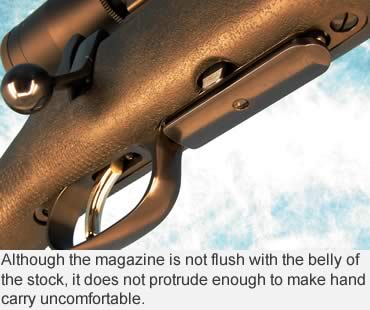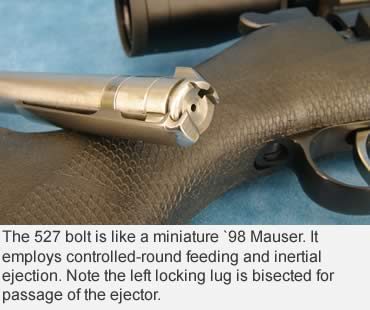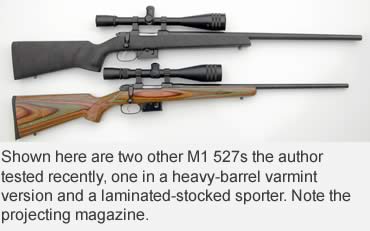By Jon R. Sundra
The M1 American is the most attractive rifle in CZ's 527 line of bolt-action sporters.
One of the most respected firearms manufacturers in the world is Ceska Zbrojovka, which explains why the company goes by the simple acronym CZ. Based in the town of Uhersky Brod in the Czech Republic, the company’s 200 acres of buildings make it the largest small arms factory in the world.
CZ has close historic ties with the other Czech arms factory based in Brno, which is best known for producing superb examples of the `98 Mauser both before and after the first World War. In fact, because the Brno name was so much better known throughout the world, when sporting arms production resumed after WWII, the CZ factory stamped their guns with their own logo as well as that of Brno, even though the Brno factory had nothing to do with CZ production. My own 1980s vintage Brno 602 that I had rechambered from .375 H&H to my .375 JRS wildcat is an example of CZ-made guns that bore both logos.
The reason CZ is not a household name in the United States is because prior to the fall of the Iron Curtain and the formation of the independent Czech Republic in 1993, there was an embargo on goods produced in Eastern Bloc countries. It was not until CZ-USA, a subsidiary of the parent company, was established in 1996 that we Yanks were given access to CZ products.
During those decades CZ’s products could not be imported here, the company was busy establishing a reputation with hunters and shooters throughout the rest of the world, particularly in Africa. Many professional hunters use CZ magnum rifles chambered in big-bore cartridges ranging from .375 H&H to .416 Rigby and .458 Lott.
 Among the impressive assortment of gun types offered by CZ is the Model 527, a bolt-action centerfire that was originally designed around the .223 Rem family of cartridges. In that respect, it’s conceptually similar to the old Sako Vixen and the Serbian-made Mini-Mauser as well as the current Kimber Model 84. Until the introduction this year of the new M1 American — the subject of this article — this rifle had a detachable magazine that projected about 1 1/4 inches below the belly of the stock and was contiguous with the forward edge of the trigger guard bow. This arrangement not only looks ungainly, it is also at the balance point of the gun. This becomes a problem if you want to carry it one-handed at your side. And other than having a gun slung over a shoulder, that’s the way most of us carry a rifle.
Among the impressive assortment of gun types offered by CZ is the Model 527, a bolt-action centerfire that was originally designed around the .223 Rem family of cartridges. In that respect, it’s conceptually similar to the old Sako Vixen and the Serbian-made Mini-Mauser as well as the current Kimber Model 84. Until the introduction this year of the new M1 American — the subject of this article — this rifle had a detachable magazine that projected about 1 1/4 inches below the belly of the stock and was contiguous with the forward edge of the trigger guard bow. This arrangement not only looks ungainly, it is also at the balance point of the gun. This becomes a problem if you want to carry it one-handed at your side. And other than having a gun slung over a shoulder, that’s the way most of us carry a rifle.
By reducing the cartridge capacity from five rounds to three, they were able to get the new box to where it juts out only 1/8 inch from the belly of the stock — not enough to feel when carrying the gun in your hand.
The last time I reviewed a CZ 527, about three years ago, I made the comment that I’d much rather have a three-round magazine than the existing one. Whether or not that had any influence on the design, I can’t say, but it couldn’t have hurt. The M1 version is so much more attractive that I’m betting the other seven models will be switched over.
In conjunction with this new shortened magazine is a redesigned trigger guard bow. On those 527s still retaining the five-round box, the front surface of the guard bow serves as an anchor point and guide; on the M1 American, it stands alone like most other conventional bottom-metal units. This, too, contributes to the much improved looks of the gun.
 The gun sent us for T&E was the M1 American, which sits in a basic black synthetic stock. The other iterations consist of the identical barreled action in a traditional walnut stock, and the M1 Ultralight Predator, which is essentially the M1 American sheathed in a predominantly green camo pattern.
The gun sent us for T&E was the M1 American, which sits in a basic black synthetic stock. The other iterations consist of the identical barreled action in a traditional walnut stock, and the M1 Ultralight Predator, which is essentially the M1 American sheathed in a predominantly green camo pattern.
M1s are available in .223 Rem only. Other 527s are available in .22 Hornet, .222 Rem, .17 Rem Fireball and .204 Ruger.
As it came from the box, the test gun weighed 5 pounds, 13 ounces.
Like its larger siblings, the .30-06-length Model 550 and 550 Magnum, the 527 platform is basic `98 Mauser as far as feeding, lockup, extraction and ejection are concerned. That means there’s a non-rotating extractor on the bolt body and a flush bolt face that allows the rims of cartridges feeding up from the staggered column box magazine to slip up behind the claw for controlled-round feeding.
And like the Mauser, the left locking lug is bisected for passage of an ejector blade that’s housed in the left wall of the receiver bridge. Spent rounds are ejected courtesy of the inertia generated when the rim of the cartridge carried rearward suddenly comes in contact with the static ejector arm. Stopping short of fully withdrawing the bolt allows spent cases to be plucked manually from the loading port.
The 527’s receiver is a forging with an integral recoil lug and a scope-mounting dovetail. I’ve always favored integral mount rails over screw-on bases because it eliminates six components: two bases and the four screws to hold them (the new Browning X-Bolt employs four screws for each base!). To make things even easier, CZ includes a set of steel scope rings, just like Ruger does with its rifles. That represents a real added value.
 Other features found on the 527 are a bolt stop/release consisting of a simple, spring-loaded pivoting lever housed in the left wall of the receiver bridge. Depressing the serrated rear end of the lever pivots the front end outward, allowing the bolt to be removed. It’s a simple, straightforward system that’s strong and reliable.
Other features found on the 527 are a bolt stop/release consisting of a simple, spring-loaded pivoting lever housed in the left wall of the receiver bridge. Depressing the serrated rear end of the lever pivots the front end outward, allowing the bolt to be removed. It’s a simple, straightforward system that’s strong and reliable.
The company states in its catalog that “The CZ 527 has won more awards in the light rifle category in Europe than any other rifle ever.” That’s partly because the 527 comes standard with a set trigger, a popular feature with European hunters. In fact, not only is this type trigger furnished on all 527s, but it’s standard on all CZ rifles — even the Model 550 Safari Magnum chambered for the big African calibers!
As with all set triggers, this one can be used in conventional mode by simply pulling it rather than first engaging the “set.” Doing so, the trigger on the test gun released at 4 pounds and had about 1/8 inch of creep, which is not unusual for a set trigger in the unset mode. By placing the tip of the forefinger behind the finger piece and pushing forward, the trigger sets with a decidedly tactile feel and an audible click. In set mode, the finger piece is positioned about midway in the guard bow, requiring a slight stretch to reach it.
The trigger broke at 21 ounces in set mode. The set can be deactivated by pulling the trigger with the safety on, or by opening the bolt and then pulling the trigger. Either way, the action reverts to its normal single-stage mode.
The safety works the opposite of what we’re used to, in that pushing the side lever forward locks the bolt and blocks the sear.
The root of the bolt handle turns down into a recess in the floor of the receiver bridge, providing yet another safety feature.
 All versions of the M1 sport 22-inch hammer-forged barrels that measure .575 inch at the muzzle.
All versions of the M1 sport 22-inch hammer-forged barrels that measure .575 inch at the muzzle.
It should also be noted that both the synthetic and the walnut stock have been redesigned with better ergonomics in the grip area.
The barrel is free-floated in the stock, which except for the squared-off fore-end tip, has nice classic lines. It’s distinctive but not as attractive as a rounded one, in my view.
To ready the test gun for the range, I used the provided rings to mount a new Leupold FX III 25x40mm fixed-power scope. That’s a lot more power than anyone needs on a .223, but it sure minimizes aiming error. The magnification is impressive, considering how short and light the scope is. Ready to go, the test gun weighed 7 pounds 14 ounces.
Range conditions were none too good, as winds were gusting to around 15 mph, and there was enough mirage through the 25x Leupold to be a factor. Still, the table below reflects pretty darn good accuracy. One load averaged just under MOA for three five-shot groups, and another managed 1.10 inches. Under better range conditions, I know I could have gotten more out of the gun. All shooting was done at 100 yards using the set trigger, and all figures are rounded to the nearest .05 inch.
As I mentioned earlier, I like this new M1 version of the 527. By shortening the magazine so that it’s nearly flush with the belly of the stock, and redesigning the trigger guard bow and the stock, it makes for a more handsome rifle.
My only criticism is that the magazine is very difficult to charge, particularly when trying to insert the third round. The rear end of the follower doesn’t want to lower, and I had to use my little finger to push it down to allow that third cartridge to slide into place. I’ve got smaller than average hands, so I’m betting the average guy is going to find it very frustrating. The magazine needs work, but I’m sure it can be remedied by redesigning the feed lips or the follower spring.
Editor’s Note: The M1 American with a synthetic stock carries an MSRP of $665. A version with a flush-mount magazine has been added since this article first appeared.
This article was published in the October 2009 edition of Buckmasters GunHunter Magazine. Subscribe today to have GunHunter delivered to your home.